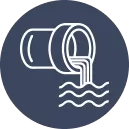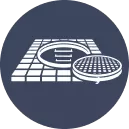Proper drainage is one of the most critical aspects of sustainable agriculture. Without efficient drainage systems, soil structure deteriorates, crops suffer, and productivity plummets. Whether you're managing a small farm or a large-scale agricultural operation, implementing effective drainage solutions ensures your land remains fertile, workable, and high-yielding. This category offers a comprehensive range of agricultural drainage products and systems designed to optimize soil conditions and enhance your farming success.
Why Drainage Matters in Agriculture
Effective drainage improves soil aeration, reduces the risk of waterlogging, and enhances root development. When soil becomes saturated, oxygen levels drop, preventing roots from accessing essential nutrients. This can lead to stunted crop growth, increased disease susceptibility, and reduced yields. Proper drainage prevents these issues by channeling excess water away from crop roots and restoring optimal soil balance.
Agricultural drainage systems also help manage stormwater, reduce erosion, and minimize the accumulation of harmful salts in the root zone. This is especially important in clay soils, low-lying areas, or fields prone to seasonal flooding. By investing in the right drainage solutions, farmers can improve soil health, extend the planting season, and maximize long-term profitability.
Types of Agricultural Drainage Systems
Understanding the different types of drainage systems is essential for choosing the right solution for your land:
1. Surface Drainage
Surface drainage involves reshaping the land to allow water to flow naturally off the field. This includes the use of shallow ditches, grassed waterways, and land grading. Surface drainage is ideal for removing excess water caused by heavy rains and helps prevent standing water on crop fields.
Products available in this category may include:
- Field ditches and grading tools
- Surface water channels
- Open drain maintenance tools
2. Subsurface (Tile) Drainage
Subsurface drainage uses perforated pipes (also known as drain tiles) buried beneath the soil surface to collect and redirect excess water. This system is highly effective in fields with high water tables or poorly drained soils. Tile drainage improves soil structure, increases root penetration, and allows for timely field access even after rainfall.
Key components include:
- Perforated drain pipes (corrugated or smooth)
- Fittings and connectors
- Filter fabrics and geotextiles
- Drainage chambers and outlets
3. French Drains
French drains combine gravel-filled trenches with perforated pipes to redirect water away from specific areas. These systems are commonly used in orchards, greenhouses, and areas with compacted soil or heavy foot traffic.
4. Mole Drainage
Mole drainage is a temporary method often used in heavy clay soils. It involves pulling a torpedo-shaped implement through the soil to create channels that improve drainage. Though it has a shorter lifespan than tile drainage, it’s an economical option for certain applications.
Drainage Accessories and Supplies
Beyond pipes and ditches, effective drainage systems require a range of supporting products. Our selection includes:
- Drainage pipe couplings and fittings
- Inspection chambers and catch basins
- Non-woven and woven geotextile fabrics
- Sump pumps and float switches
- Water level monitoring systems
- Trench shields and installation tools
These components ensure a durable, functional, and easy-to-maintain drainage setup tailored to your field conditions.
Benefits of Agricultural Drainage
Investing in high-quality drainage systems delivers measurable returns over time. Key benefits include:
- Improved crop yields: Healthy root systems and optimal soil moisture lead to better plant performance.
- Reduced soil compaction: Fields dry out faster, allowing for timely machinery access without damaging soil structure.
- Minimized disease risk: Standing water promotes fungal and bacterial diseases. Drainage systems reduce this threat.
- Enhanced nutrient retention: By preventing waterlogging, drainage helps preserve essential nutrients in the root zone.
- Increased operational efficiency: Drainage allows for earlier planting, faster harvesting, and fewer delays due to wet conditions.
Applications for Farm Drainage
Drainage is essential for various types of agricultural operations, including:
- Row crop farming
- Vineyards and orchards
- Livestock pastures and feedlots
- Greenhouses and nurseries
- Turf and sod farms
- Horticultural installations
Whether you're cultivating soybeans in a wet Midwest field or managing a fruit orchard in a valley prone to runoff, choosing the right drainage system is key to your operation’s sustainability.
Sustainable Drainage Practices
As climate variability increases and regulations evolve, sustainable drainage practices are becoming increasingly important. Our products support environmentally responsible water management by:
- Minimizing runoff and soil erosion
- Protecting nearby waterways from nutrient pollution
- Promoting water reuse and groundwater recharge
- Supporting integrated water resource management (IWRM)
We also offer advice and technical support for designing drainage systems that meet conservation compliance standards and contribute to long-term farm resilience.
Choosing the Right Drainage Products
Selecting the right drainage system depends on several factors, including:
- Soil type and permeability
- Field slope and topography
- Rainfall patterns
- Crop type and planting schedule
- Regulatory requirements
Our team of agricultural drainage experts is here to help you choose the right system for your needs. We offer technical guidance, layout planning, and product recommendations tailored to your specific farm conditions.
Installation and Maintenance Tips
Proper installation and regular maintenance are vital for ensuring drainage system longevity and performance. Here are a few essential tips:
- Always use the correct pipe grade and depth to ensure consistent water flow.
- Install silt traps and inspection ports to facilitate cleaning.
- Avoid compacting soil over drain lines during field operations.
- Schedule regular inspections, especially after heavy rains or seasonal changes.
- Flush or jet clean lines annually to prevent clogging.
By following best practices and using reliable equipment, you can extend the life of your system and avoid costly repairs.
Shop Agricultural Drainage Solutions
Explore our complete range of agricultural drainage products tailored to every type of field condition. From durable subsurface tile systems to sustainable surface water management tools, we provide everything you need to improve soil drainage and farm productivity.
Our inventory includes trusted brands, competitively priced supplies, and fast shipping options for farmers, landscapers, and agricultural contractors. Whether you're upgrading an existing system or installing new drainage lines, you'll find the products and expertise to make the process seamless.
Optimize your land. Protect your crops. Invest in professional-grade agricultural drainage solutions today.










